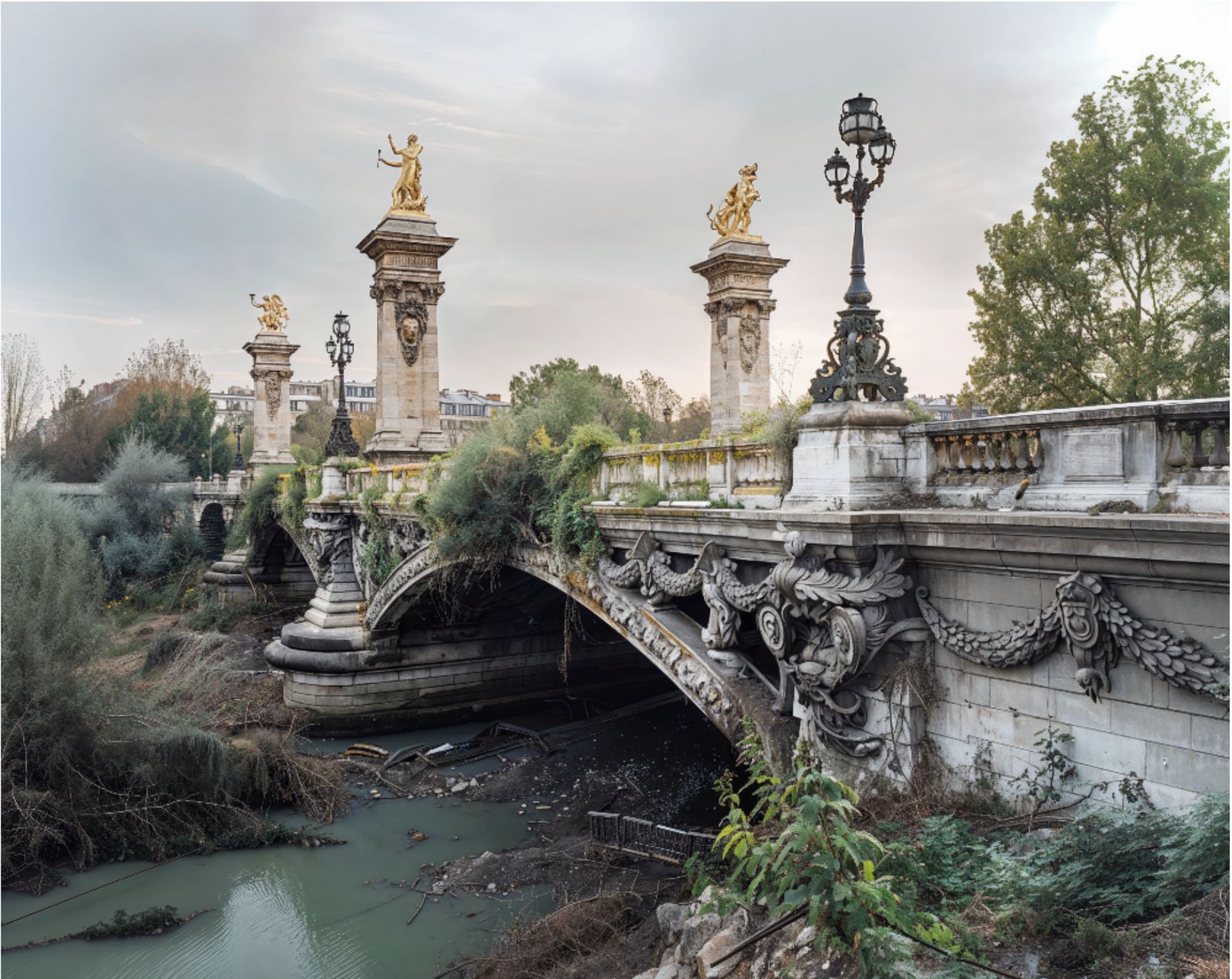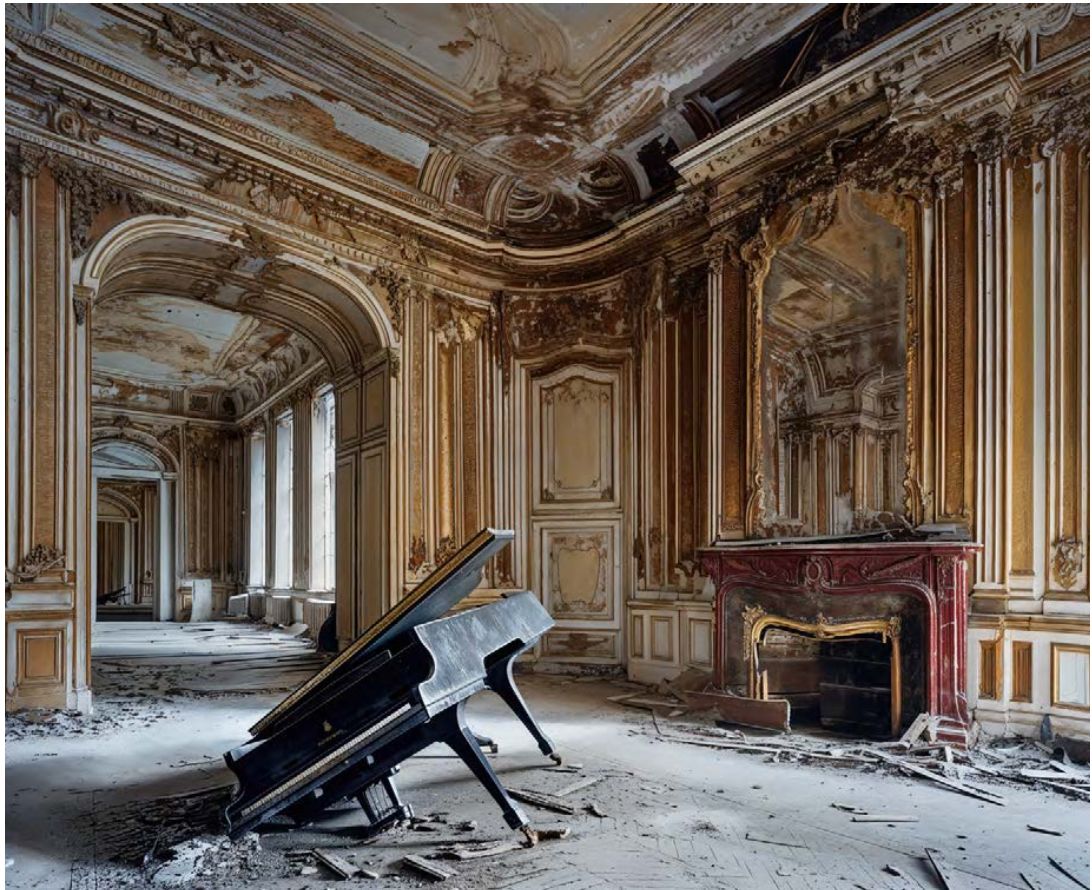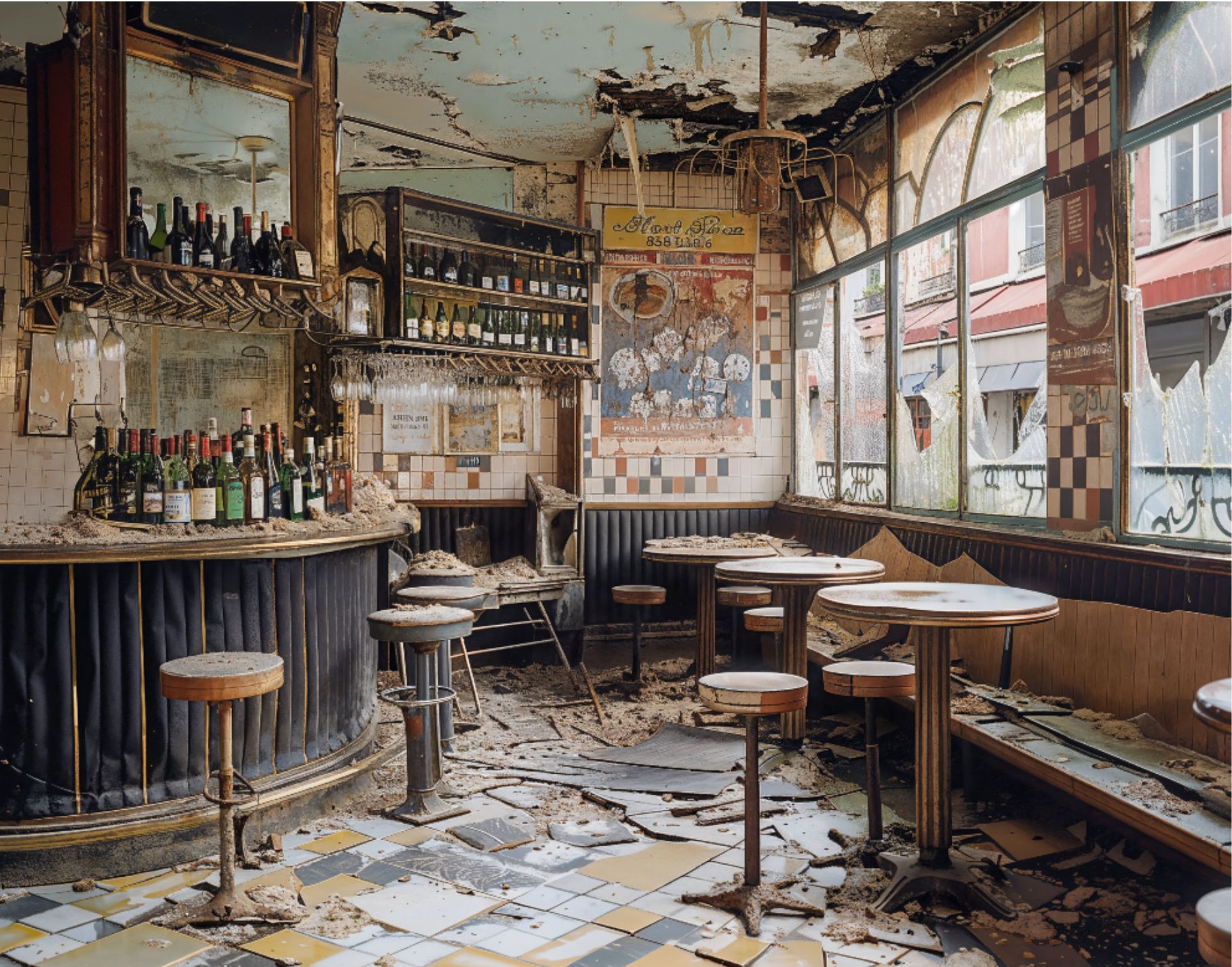09 february 2025, Yves Joris
The staged decline of Paris
The exhibition 'Les Ruines de Paris' by Marchand & Meffre at Galerie Fontana immerses the viewer in a paradoxical reality in which the grandeur of Paris slowly crumbles into poetic decay. But this is not a case of random deterioration, rather a carefully composed scenography that reveals the fragile balance between past and future. In this artistic exploration, I examine how this exhibition is not just an ode to ruins, but also a philosophical reflection on the city as a living organism. I am guided by the words of Oswald Spengler, who suggested that every culture undergoes the same life stages as an individual: childhood, youth, adulthood and old age.
The silent spectacle of decay
Marchand & Meffre are renowned for their photographic masterpieces that expose a fascination with abandoned architecture and urban decay. 'Les Ruines de Paris' continues this tradition, but with a surprising twist. The ruins are not merely the result of neglect or time, but deliberately staged, as artificial memories of a future past. Each image evokes a deep melancholy: abandoned stations, collapsed theatres and dilapidated apartments symbolise a world in which human presence seems nothing more than a fleeting passage.

Marchand & Meffre, Les Ruines de Paris | Pont, 2024, Galerie Fontana
These artificial ruins invite contemplation. They confront us with the transience of what was once majestic, while simultaneously raising questions about the role of art and photography in capturing decay. Is this decline a warning or an invitation to find beauty in what has been lost?
The details in the photographs amplify this sense of estrangement. Plants growing through concrete cracks, peeling paint on once-magnificent facades — these elements suggest the ever-recurring and indestructible force of nature, even in a world abandoned by humans, creating a tension between the artificial and the organic, between what is constructed and what has fallen into ruin.
The broken pyramid: a reflection on human impermanence
One particularly powerful image in the exhibition depicts the iconic glass pyramid of the Louvre, shattered across the desolate courtyard. What was once a symbol of transparency, progress and cultural triumph now lies broken, a monument to human vulnerability. The sharp fragments and deep cracks pose an unsettling question: how enduring are the symbols of civilisation really?
The geometric perfection of the pyramid — originally an ode to rationality and order — has been transformed into a mesmerising spectacle of chaos. The glass, once clear and reflective, now lies scattered as diffuse rubble. Yet in this destruction, an unexpected aesthetic emerges: beams of light fracture through the shards, casting irregular patterns on the empty courtyard. This transition from perfection to disorder serves as a visual metaphor for the fragility of human systems. While we strive for control and symmetry, nature asserts itself as the ultimate architect of unpredictability.
Spengler’s idea of the cyclical nature of civilisations resonates in this image. The pyramid is not a definitive ruin, but a memento mori: a reminder of the impermanence of human creations and an invitation to reflect. Perhaps there is strength to be found in accepting transience.

Marchand & Meffre, Les Ruines de Paris | Restaurant, 2024, Galerie Fontana
Paris as organism: from youth to old age
Once the youthful and vibrant capital of the world, in these staged ruins Paris appears as a city that has long left its glory days behind it. Just as an individual moves through different phases of life, so too has Paris experienced its peak of cultural flourishing, romance and revolution. But what happens when a city matures and reaches its inevitable old age?
It is tempting to associate old age with decline and loss, but 'Les Ruines de Paris' suggests that this is not necessarily the case. Aging can also bring tranquillity, wisdom and reflection. Paris has continually reinvented itself throughout the centuries. From the golden age of the Belle Époque to the modernist revolutions of the 20th century, the city has often seemed to lose itself, only to be reborn anew. Through their work, Marchand & Meffre show that even in the stage of old age, beauty and meaning can still be found.
The philosophy of artificial decay
The staged ruins also elicit questions about authenticity and representation. Can ruins that are deliberately created have the same impact as natural ruins? The answer perhaps lies in their symbolic power. By consciously depicting a ‘future past’, Marchand & Meffre compel us to reflect on the cyclical nature of time and history.
This idea aligns with Oswald Spengler’s philosophical pessimism. Spengler considered the decline of civilisations not as an unfortunate accident, but as an inevitable fate. Just as a flower blooms before withering, he described cultures that reach a glorious peak, only to slowly deteriorate. This pessimism permeates the exhibition: a city that was once the symbol of light and progress now stands as a relic of a bygone world.

Marchand & Meffre, Les Ruines de Paris | Piano, 2024, Galerie Fontana
Yet, there is something paradoxically comforting about these images. In their controlled decay, they suggest that the downfall of civilisations does not have to be an end, but rather a transformation into a new state of being. These deliberately crafted images bring a post-apocalyptic vision of Paris to life. The city is transformed into a timeless place, detached from its concrete history. This raises questions about our collective future. What happens when the symbols of our civilisation collapse? Will anything remain that still holds meaning?
These artificial ruins serve as a mirror for our fears and desires. They show us a world in which even the most iconic symbol of civilisation — Paris — is not immune to decay. Yet at the same time, they also offer hope: within this decline lies the potential for renewal and transformation.
The sublime in the imperfect
One of the most striking aspects of the exhibition is how it finds beauty in the imperfect. The aesthetics of decay invite the viewer to see the world differently. Instead of perceiving deterioration as something negative, we can view it as an essential part of life. Just as a scar tells a story of healing, these ruins tell stories of transformation and resilience.
The concept of the sublime in imperfection aligns with the Japanese aesthetic of wabi-sabi, which embraces transience and imperfection as sources of beauty. But whereas wabi-sabi seeks peace in the earthly and natural, 'Les Ruines de Paris' confronts us with the tension between humanity and nature. The images suggest that even when humanity disappears, something always remains — a faint memory, a trace in stone.
This tension between destruction and transformation ensures that the exhibition is not only about the past, but also about the future. What ruins will we leave behind? And what stories will they tell?

Marchand & Meffre, Les Ruines de Paris | Cafe, 2024, Galerie Fontana
Reflection and future perspective
What remains of a city when its physical structure crumbles? Perhaps it is not the physical city that matters, but the memories, stories and cultural meaning it carries. Just as an individual lives on in the memories of others, a city can endure in collective imagination.
Marchand & Meffre do not offer easy answers, but instead invite reflection. In an era in which cities are constantly being renewed and modernised, this exhibition reminds us that decay does not have to mean the end; it can be the beginning of a new way of seeing, thinking and feeling.
In the images of Marchand & Meffre, Paris becomes a metaphor for every great civilisation that once stood at its peak. By portraying a future past, they emphasise the perpetual cycles of rise, bloom and decline that are inherent to human societies. This not only provides a visual spectacle, but also a valuable lesson about the resilience and transformation of culture.
While Spengler’s philosophical pessimism warns of inevitable decline, this exhibition suggests that within this deterioration, there is also a certain beauty. Ruins are not merely remnants of what was; they are also the foundations on which a new story can be built.
Galerie Fontana will soon be opening a location in Brussels (16 Watteeustraat), where 'Les Ruines de Paris' will be shown again from 8 May - 12 July.
